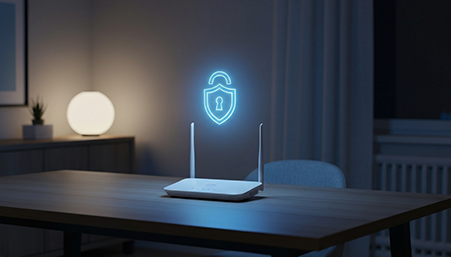10 Ways to Make Your WiFi Network Hacker-Proof

A Beginner’s Guide on How to Protect WiFi Network from Hackers
Our whole online existence is on WiFi. The sooner we realize this, the better we can optimize ourselves to enjoy a safe and secure wifi connection. When you are watching your favorite show, attending Zoom meetings, or playing games with friends, have you ever stopped to think – “Is my WiFi network actually safe?”
If not, you are not alone. Most people set up their routers, plug in their devices, and never give it a second thought. And that's where the problems begin. Hackers search for and attack unprotected WiFi networks. But you don’t need to be a tech genius to secure your WiFi connection.
In this blog, we’ll walk you through 10 simple, actionable steps on how to secure WiFi connection, protect it from unwanted users, and even check if your WiFi has been hacked.
1. Rename Your WiFi Network (SSID)
Don't leave the default name! When you keep the router's name (SSID) as the default, it exposes the router's make and model. This information can be used by hackers to attack known weaknesses.
Select a custom SSID that does not contain personal details. Let it be funky with meaningless but safe names such as "NotYourWiFi123"
2. Create a Strong WiFi Password
No, your pet’s name will not work. The easiest way to learn how to secure WiFi connection from hackers is to have a long password with multiple complexities that cannot be guessed. So, don’t use names, birthdays, or other common words. These are some thumb rules to follow:
- Mix upper and lower case letters
- Add digits and special characters
- Change your password every now and again
3. Turn on WPA3 Encryption
Better than WPA2, and far better than nothing. WPA3 is the best protocol right now. This encryption jumbles up your information so other people can't view what you are doing online. If your router isn't compatible with it, at least turn on WPA2.
Here’s how you turn on WPA3 on your router: access your router settings using a web browser, look for the WiFi or Wireless settings, and choose WPA3 as the security type.
4. Turn off WPS (Wi‑Fi Protected Setup)
Convenient? Yes. Secure? Not really. WPS lets you connect devices with just a button-push. But that convenience has security gaps which can let hackers get onto your network without a WiFi password. So, turn it off to keep your network tight.
5. Hide Your Network
Out of sight, out of hackers’ minds. You can choose to “hide” your SSID, meaning it won't appear in the list of networks. This adds a security layer.
Naturally, your devices will still be able to connect—you will simply have to enter the SSID manually the first time around.
6. Update Your Router Firmware
Because outdated software is an open door for up-to-date hackers. The same way your mobile phone needs to be regularly updated to repair bugs and seal vulnerabilities, your router does too. You can see how to secure WiFi network by checking regularly for firmware updates in the admin panel of your router.
Log in to your router web interface, find the firmware update section (usually under maintenance), and look for updates.
7. See Who’s On Your WiFi
Are strangers stealing your bandwidth? Let’s find out! Here’s how to check how many devices are connected to WiFi:
- Log in to your router’s admin page
- Go to “Device List” or “Attached Devices”
- Remove unknown devices and reset your password
You can also use apps like Fing or NetCut to get an extensive list. No more browsing “how to check how many people using my WiFi?” Here is your answer.
8. Turn Off Remote Management
You don’t need your router at work! Remote access lets you control your router from anywhere, but that makes it simple for hackers too. Go to your router settings and turn off “Remote Management” and leave the home network at home.
9. Schedule WiFi Downtime
WiFi downtime and digital detox, all at once! Most routers let you schedule a time when the WiFi turns off, like at night or when you are out working. Fewer active hours means fewer chances for a hacker to sneak in. Easy!
10. Check Your Internet Speed
Slow WiFi? It may be more than just poor internet connection. Sudden speed drops can mean there has been a breach. If you ever notice strange activity, it is best to do a hack check by seeing the connected devices, usage history, and router logs.
Would you like to know how to check internet speed? Open your go-to browser and use trustable tools such as:
- Speedtest by Ookla
- Fast.com by Netflix
- Your ISP’s app or portal
Bonus Tip: Rely on a Trusted Network
Although you followed all the precautions on how to secure your WiFi network from hackers, your efforts may be wasted if your internet service provider is not reliable. A secure home network starts with a trusted internet provider—one that provides consistent internet speed, proactive security measures, and dependable support.
That is why thousands of people opt for Hathway Broadband. Known for its stable internet connections and strong backend security, Hathway makes sure that you are not just connected, but safe.
Stay Vigilant. Stay Secure.
Protecting your WiFi connection may sound like a hassle, but taking these small steps today can save you a lot of headaches tomorrow. So the next time you are curious about how to secure WiFi network from hackers, you’ll know exactly what to do.
